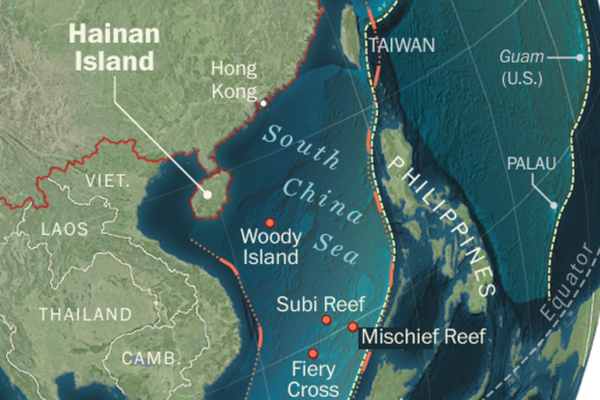TAIPEI, Taiwan/MANILA – The South China Sea has become one of the world’s most perilous geopolitical hot spots in recent years, with China stepping up the reinforcement of its expansive claims and countries from outside the region getting increasingly involved. Here are five areas to watch in 2025: Taiwan Strait The situation in the Taiwan Strait has been becoming notably more tense, with nearly 3,000 incursions into Taiwan’s air defense identification zone between January and November 2024, as well as two major military exercises – Joint Sword A and B – coinciding with important political events on the self-ruled island. Chinese leader Xi Jinping reiterated in his in 1999 to serve as an outpost. In the last few years, China’s coast guard has been blocking and disrupting Philippine resupply missions to the ship, the BRP Sierra Madre, and the troops stationed there. On June 17, 2024, in an unprecedented confrontation, China coast guard personnel, armed with pikes and machetes, punctured Philippine boats and seized firearms during a Philippine rotate and resupply mission, wounding a Filipino sailor. Both sides later called for de-escalation. On Dec. 12, China said it had granted permission to the Philippines to resupply the “illegally grounded” warship on Second Thomas Shoal on a humanitarian basis. But the June 17 incident showed that the situation could easily escalate into conflict, especially given the proximity of Second Thomas Shoal to a Chinese naval base on Mischief Reef, an artificial island that China built and has fully militarized. Manila and Washington signed a Mutual Defense Treaty in 1951 under which both parties are obliged to support each other in the event of an armed attack. U.S. Defense Secretary Lloyd Austin in November revealed that the U.S. military had set up a Task Force Ayungin, the Filipino name for the Second Thomas Shoal. Chief of the Philippine armed forces, Gen. Romeo Brawner Jr., told an RFA reporter in Manila that his country was pursuing a three-pronged strategy when it comes to maritime defense: to establish an effective presence; to create effective deterrence and modernize military equipment; and to leverage alliances and partnerships with like-minded nations. Beijing, however, is not expected to give up its demand that Manila removes the BRP Sierra Madre and leave the disputed shoal. For its part, the Philippines is determined to defend it. “We’ll never abandon our territory at Ayungin,” insisted Col. Xerxes Trinidad, the Philippine armed forces’ spokesperson. Vietnam’s island building Vietnam’s island building in the South China Sea has reached a record, with the total area created in the first six months of 2024 equaling that of 2022 and 2023 combined, according to a study by the Washington-based Asia Maritime Transparency Initiative (AMTI). Between November 2023 and June 2024, Hanoi created 692 new acres (280 ha) of land across a total of 10 features in the Spratly archipelago. Vietnam’s overall dredging and landfill totaled about 2,360 acres (955 ha), roughly half of China’s 4,650 acres (1,881.7 ha). “Three years from when it first began, Vietnam is still surprising observers with the ever-increasing scope of its dredging and landfill in the Spratly Islands,” AMTI said. Vietnam occupies 27 features and has been carrying out large-scale reclamation works on some over the past year. <imgsrc=”” alt=”Satellite image of Barque Canada Reef, May 11, 2024.” height=”813″ width=”1500″>Satellite image of Barque Canada Reef, May 11, 2024.(AMTI/Maxar Technologies) A new 3,000-meter airstrip is nearly finished on Barque Canada reef, where the total landfill area more than doubled in one year to nearly 2.5 square kilometers, or 617.7 acres, by October 2024. Vietnam has had only one airstrip on an island called Spratly, measuring 1,300 meters, but besides Barque Canada, AMTI said that “it would be unsurprising” if Hanoi also considers runways on Pearson and Ladd reefs. New bases and runways “would give Vietnam a position on the other side of China’s ‘Big Three’ islands,” said Tom Shugart, adjunct senior fellow at the Center for a New American Security. He was referring to China-developed Fiery Cross, Subi and Mischief reefs, which are the largest artificial islands in the South China Sea. The next four largest are all newly expanded Vietnamese reefs. “Its progress in the last five months suggests that Hanoi is determined to maximize the strategic potential of the features it occupies,” said AMTI, adding that “it remains difficult to say when the expansion will end—and what new capabilities Vietnam will have once it has.” Code of Conduct in the South China Sea Malaysia is taking over as chairman of the Association of Southeast Asian Nations, or ASEAN, from Laos this month and every time the chair changes hands, the question of a legally binding code of conduct (COC) for all competing parties in the South China Sea surfaces. China and ASEAN countries have been negotiating a COC after reaching an initial Declaration of Conduct of Parties in the South China Sea in 2002. More than two decades later, it seems many obstacles remain despite Beijing’s repeated assertions that the consultation process is going well and agreement is close. Premier Li Qiang told an ASEAN summit in October that China and the bloc were “striving for early conclusion” of the code of conduct. China and five other parties, including four ASEAN countries – Brunei, Malaysia, the Philippines and Vietnam – hold conflicting claims over parts of the South China Sea but China’s claim is by far the most expansive, covering nearly 90% of the sea. China is adamantly against what it sees as “a politicization” of the COC, as well as any “external interference” in the matter. Yet its assertiveness has prompted some countries to seek a counterweight from outside ASEAN. “Negotiations on the COC continue at a snail’s pace,” former Thai Foreign Minister Kantathi Suphamongkhon told Reuters news agency in October. “An agreement seems impossible,” said Philippine legal expert, former Supreme Court justice Antonio Carpio. “China will never agree to some provisions, Vietnam to some others and so on. The target of concluding the COC by 2026, therefore,…


